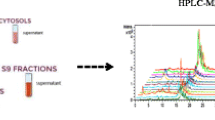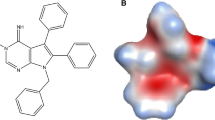Abstract
We have investigated the in vitro metabolism of three small antimicrobial β2,2-amino acid derivatives (M w < 500) that are highly potent against methicillin resistant Staphylococcus aureus, and are among the first compounds designed from small cationic antimicrobial peptides with potential for oral administration. The β2,2-amino acid derivatives are virtually completely resistant against degradation by proteases, and to further explore their drug potential, we have investigated the hepatic Phase I metabolism of this class of antimicrobial compounds. The β2,2-amino acid derivatives were incubated with murine liver microsomes and the metabolites analyzed semi-quantitatively by HPLC–MS and qualitatively by ultra performance liquid chromatography coupled to a tandem mass spectrometer which enabled identification of the metabolites by careful interpretation of the collision activated dissociation spectra. The study shows that sterically hindered β2,2-amino acid derivatives that otherwise are stable against proteolytic degradation underwent Phase I metabolism and were oxidized to a number of different metabolites depending on the structure of the β2,2-amino acid side-chains.









Similar content being viewed by others
Abbreviations
- AMP:
-
Cationic antimicrobial peptide
- BP:
-
Base peak
- CAD:
-
Collision activated dissociation
- CV:
-
Cone voltages
- CYP450:
-
Cytochrome P450 enzyme
- d P :
-
Particle diameter
- ESI:
-
Electrospray ionization
- HPLC:
-
High performance liquid chromatography
- IS:
-
Internal standard
- LoD:
-
Limit of detection
- LoQ:
-
Limit of quantification
- MIC:
-
Minimal inhibitory concentration
- MNP:
-
Methylene naphthalene
- MRSA:
-
Methicillin resistant Staphylococcus aureus
- MRSE:
-
Methicillin resistant Staphylococcus epidermidis
- MS:
-
Mass spectrometry
- NADP:
-
Nicotinamide adenine dinucleotide phosphate
- NL:
-
Neutral loss
- Q-ToF:
-
Quadrupole time of flight
- RBC:
-
Human erythrocytes
- RP:
-
Reverse phase
- SEM:
-
Standard error of the mean
- SIR:
-
Single-ion recording
- ToF:
-
Time of flight
- t R :
-
Retention time
- UPLC:
-
Ultra performance liquid chromatography
- UV:
-
Ultra violet
- VS:
-
Volume standard
References
Ackley DC, Rockich KT, Baker TR (2004) Metabolic stability assessed by liver microsomes and hepatocytes. In: Yan Z, Caldwell GW (eds) Optimization in drug discovery: in vitro methods. Humana Press, NJ, pp 151–162
Boman HG (1995) Peptide antibiotics and their role in innate immunity. Annu Rev Immunol 13:61–92
Boman HG (2003) Antibacterial peptides: basic facts and emerging concepts. J Intern Med 254(3):197–215
Boucher HW, Talbot GH, Bradley JS, Edwards JE, Gilbert D, Rice LB, Scheld M, Spellberg B, Bartlett J (2009) Bad bugs, no drugs: No ESKAPE! An update from the infectious diseases society of America. Clin Infect Dis 48(1):1–12
Cho TM, Rose RL, Hodgson E (2006) In vitro metabolism of naphthalene by human liver microsomal cytochrome P450 enzymes. Drug Metab Dispos 34(1):176–183
Corey GR, Stryjewski ME, Weyenberg W, Yasothan U, Kirkpatrick P (2009) Telavancin. Nat Rev Drug Discov 8(12):929–930
Gimenez D, Andreu C, del Olmo M-l, Varea T, Diaz D, Asensio G et al (2006) The introduction of fluorine atoms or trifluoromethyl groups in short cationic peptides enhances their antimicrobial activity. Bioorg Med Chem 14(20):6971–6978
Hagmann WK (2008) The many roles for fluorine in medicinal chemistry. J Med Chem 51(15):4359–4369
Hancock RE, Lehrer R (1998) Cationic peptides: a new source of antibiotics. Trends Biotechnol 16(2):82–88
Hansen T, Alst T, Havelkova M, Strøm MB (2010) Antimicrobial activity of small β-peptidomimetics based on the pharmacophore model of short cationic antimicrobial peptides. J Med Chem 53(2):595–606
Hansen T, Ausbacher D, Flaten GE, Havelkova M, Strøm MB (2011) Synthesis of cationic antimicrobial β2,2-amino acid derivatives with potential for oral administration. J Med Chem 54(3):858–868
Haug BE, Skar ML, Svendsen JS (2001) Bulky aromatic amino acids increase the antibacterial activity of 15-residue bovine lactoferricin derivatives. J Pept Sci 7(8):425–432
Haug BE, Stensen W, Stiberg T, Svendsen JS (2004) Bulky nonproteinogenic amino acids permit the design of very small and effective cationic antibacterial peptides. J Med Chem 47(17):4159–4162
IDSA (2004) Bad bugs, no drugs. Infectious Diseases Society of America
Kirk KL (2006) Fluorine in medicinal chemistry: recent therapeutic applications of fluorinated small molecules. J Fluorine Chem 127(8):1013–1029
Li C, Haug T, Moe MK, Styrvold OB, Stensvag K (2010) Centrocins: isolation and characterization of novel dimeric antimicrobial peptides from the green sea urchin. Strongylocentrotus droebachiensi. Dev Comp Immunol 34(9):959–968
Livermore DM (2009) Has the era of untreatable infections arrived? J Antimicrob Chemother 64(Suppl 1):i29–i36
Mills RF, Adams SS, Cliffe EE, Dickinson W, Nicholson JS (1973) The metabolism of ibuprofen. Xenobiotica 3(9):589–598
Moe MK, Strøm MB, Jensen E, Claeys M (2004) Negative electrospray ionization low-energy tandem mass spectrometry of hydroxylated fatty acids: a mechanistic study. Rapid Commun Mass Spectrom 18(15):1731–1740
Neu HC (1992) The crisis in antibiotic resistance. Science 257(5073):1064–1073
Norrby SR, Nord CE, Finch R (2005) Lack of development of new antimicrobial drugs: a potential serious threat to public health. Lancet Infect Dis 5(2):115–119
Opar A (2007) Bad bugs need more drugs. Nat Rev Drug Discov 6(12):943–944
Park K, kitteringham NR, O′Neill PM (2001) Metabolism of fluorine-containing drugs. Annu Rev Pharmacol 41:443–470
Paterson JW, Conolly ME, Dollery CT, Hayes A, Cooper RG (1970) The pharmacodynamics and metabolism of propranolol in man. Eur J Clin Pharmacol 2(3):127–133
Peet NP (2010) Drug resistance: a growing problem. Drug Discov Today 15(15–16):583–586
Samuelsen O, Haukland HH, Jenssen H, Kramer M, Sandvik K, Ulvatne H, Vorland LH (2005) Induced resistance to the antimicrobial peptide lactoferricin B in Staphylococcus aureus. FEBS Lett 579(16):3421–3426
Strøm MB, Haug BE, Skar ML, Stensen W, Stiberg T, Svendsen JS (2003) The pharmacophore of short cationic antibacterial peptides. J Med Chem 46(9):1567–1570
Svenson J, Stensen W, Brandsdal B, Olav, Haug BE, Monrad J, Svendsen JS et al (2008) Antimicrobial peptides with stability toward tryptic degradation. Biochemistry 47(12):3777–3788
Tew GN, Clements D, Tang H, Arnt L, Scott RW (2006) Antimicrobial activity of an abiotic host defense peptide mimic. Biochim Biophys Acta-Biomemb 1758(9):1387–1392
Tew GN, Scott RW, Klein ML, DeGrado WF (2010) De novo design of antimicrobial polymers, foldamers, and small molecules: from discovery to practical applications. Acc Chem Res 43(1):30–39
Tindell GL, Walle T, Gaffney TE (1972) Rat liver microsomal metabolism of propranolol: identification of seven metabolites by gas chromatography-mass spectrometry. Life Sci 11((21, Part 2)):1029–1036
Tørfoss V, Ausbacher D, Cavalcanti-Jacobsen CD, Hansen T, Brandsdal BO, Havelkova M, Strøm MB (2012) Synthesis of anticancer heptapeptides containing a unique lipophilic beta(2,2) -amino acid building block. J Pept Sci. doi: 10.1002/psc.1434
Vasskog T, Berger U, Samuelsen PJ, Kallenborn R, Jensen E (2006) Selective serotonin reuptake inhibitors in sewage influents and effluents from Tromso Norway. J Chromatogr A 1115(1–2):187–195
Acknowledgments
We thank Dr. Jack Bruun for technical assistance with running the Q-ToF experiments as well as Dr. Espen Hansen for help with obtaining the HRMS spectra.
Author information
Authors and Affiliations
Corresponding author
Rights and permissions
About this article
Cite this article
Hansen, T., Moe, M.K., Anderssen, T. et al. Metabolism of small antimicrobial β2,2-amino acid derivatives by murine liver microsomes. Eur J Drug Metab Pharmacokinet 37, 191–201 (2012). https://doi.org/10.1007/s13318-012-0086-9
Received:
Accepted:
Published:
Issue Date:
DOI: https://doi.org/10.1007/s13318-012-0086-9




